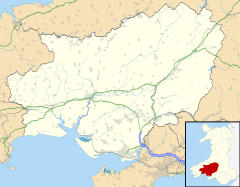Glanamman
| Glanamman | |
|---|---|
 Bethania Calvinistic Methodist Chapel |
|
| Glanamman shown within Carmarthenshire | |
| Population | 2,261 (2001 census) |
| OS grid reference | SN675134 |
| Community | |
| Principal area | |
| Ceremonial county | |
| Country | Wales |
| Sovereign state | United Kingdom |
| Post town | AMMANFORD |
| Postcode district | SA18 |
| Dialling code | 01269 |
| Police | Dyfed-Powys |
| Fire | Mid and West Wales |
| Ambulance | Welsh |
| EU Parliament | Wales |
| UK Parliament | |
| Welsh Assembly | |
Glanamman (Welsh: Glanaman) is a Welsh mining village in the valley of the River Amman in Carmarthenshire. Glanamman has long been a stronghold of the Welsh language; village life is very largely conducted in Welsh. Like the neighbouring village of Garnant it experienced a coal-mining boom in the 19th and early 20th centuries, but the last big colliery closed in 1947 and coal has been extracted fitfully since then.
The location of Garnant and Glanamman was known as Cwmamman ("Amman valley") before coal was discovered; until the 18th century it was a remote wilderness with just a few farms and rough mountain roads. Mining appears to have started at Brynlloi in 1757 and small coal workings proliferated in the first half of the 19th century. The arrival of the railway in 1840 meant that coal could be exported on an industrial scale through Llanelli docks, and the construction of two stations at Glanamman and Garnant promoted a distinction between the two communities.
Taking its name from the emblem of the Dynevor family, the "Raven" colliery in Garnant was operating by 1854. In 1891, the Gelliceidrim Collieries Company opened what became the largest of the coal mines at Glanamman, employing 632 men in 1932. "The Gelly" was nationalised in 1947 and closed in 1957. Since then the area has seen some small private mines come and go, such as a drift mine on Grenig Road in the 1970s.
Cwmamman, the old name for the location of Glanamman and Garnant, was revived for the modern urban council covering the two villages which now have much smaller populations than in their heyday at the turn of the 20th century. Glanamman is in the unitary authority of Carmarthenshire. Rhodri Glyn Thomas of Plaid Cymru currently represents the village at the Welsh Assembly in the constituency of Carmarthen East and Dinefwr. He had a majority of 8,000 votes over Labour's Kevin Madge in the Welsh Assembly Elections 2007.
The village is about 13 miles north of Swansea on the edge of the Black Mountain, in the westernmost part of the Brecon Beacons National Park. The River Amman flows through the village. Glanamman lies in the western part of the South Wales Coalfield, where the coal is particularly high-quality anthracite.
...
Wikipedia

